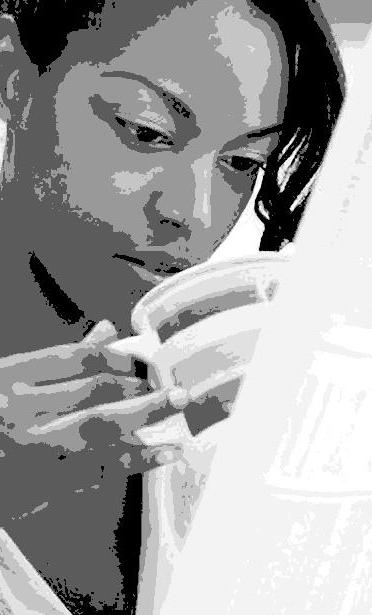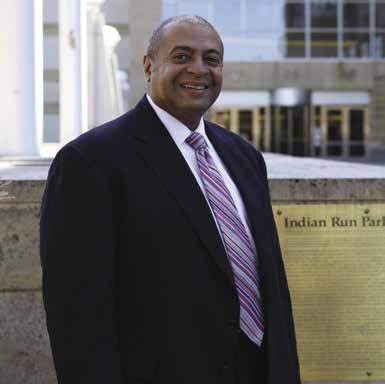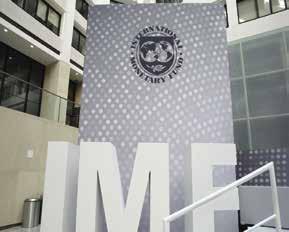
17 minute read
OpEd
EDITORIAL
Turning the Tide Against the Toxic State
These are trying times to say the least and the intensity of the challenges Americans are facing is creating a toxic state. Day in and day out, news of violence, injustice, sickness and death is having a very real impact on the mental health of adults and children, alike.
As difficult as it’s been to watch the trial of Derek Chauvin, the Minneapolis police officer facing first, second and third degree murder charges for the killing of George Floyd, many Americans are glued to their screens watching the daily recount of evidence and testimonies, including the horrific video, showing the heinous act that led to Mr. Floyd’s death. The hope for justice in this case is restrained by pessimism resulting from not guilty verdicts most in law enforcement receive, particularly for acts against Black people. But we sit, and watch, and cry, and relive the pain, while our children watch, too.
Then, there’s cause to celebrate the arrival of three vaccines — Pfizer, Moderna and Johnson & Johnson — that will make Americans safer against COVID-19. But, the promise of reopening, traveling and gatherings is tempered by the threat of a fourth surge and reluctance by many to take the vaccine. Life as we knew it has not returned, and when it will is unpredictable. Upcoming holiday celebrations and much anticipated graduations will be put on hold or delayed once again. Instead of tossing tasseled caps with excitement in the air, graduates will sadly lower their computer screens to mark the momentous occasion in 2021.
The U.S. is among the leading countries with the highest prevalence of mental disorders. In the 2021 report on the State of Mental Health in America, mental health among adults is increasing and youth mental health is worsening. The stresses of life do not discriminate, and the response including drug abuse, alcoholism and suicide, don’t discriminate either.
The government’s response is stimulus payment. And while it addresses a financial crisis, it is not a cure for anxiety of depression. People need help and access to mental health care without stigma or shame. Let’s talk about it, and ensure affordability and accessibility for everyone who needs today. WI
With George Floyd’s Murder Televised for All, How Will Children Be Effected?
As the Derek Chauvin trial enters its second week, viewers have seen witnesses for the prosecution testify that the former police offer’s restraint of the victim, George Floyd, did not follow standard police tactics or training. In Chauvin’s defense, lead attorney Eric J. Nelson has attempted to bolster his argument that his client may have found it difficult to provide medical assistance or to remove his knee which he held on Floyd’s neck for more than nine minutes because of the crowd around him.
Still, with Floyd being heard saying that he could not breathe and even crying out to his deceased mother, and with several onlookers pleading that Chauvin remove his knee, it’s hard to imagine that a more humane solution could not have been employed by him and his fellow officers.
Legal experts believe that the trial will continue for at least another several weeks. In the meantime, the grim scene of Floyd’s slow death, allegedly due to asphyxiation, has been rebroadcast – in part and in its totality – numerous times.
And unfortunately, it’s not just grown folks who are watching the murder scene. With most schools still providing instruction virtually and with YouTube and other social media platforms making the trial easily accessible, perhaps the real question remains not how many people will see what Chauvin did but how few?
Viewer interest in television coverage of the trial has been high based on ratings data from Nielsen with one cable channel, HLN, broadcasting its entirety since the proceedings started on March 29. In fact, HLN, which averaged 470,000 viewers for the one-hour slot beginning at 3 p.m. on Monday, reported its highest daytime ratings since 2013 when viewers watched the trial of George Zimmerman – the neighborhood watch volunteer who fatally shot Trayvon Martin, an unarmed Black teenager.
“The numbers show that there is a high level of interest,” said Ken Jautz, an executive vice president of CNN, who oversees HLN, in an interview. “This trial raises so many prominent and searing societal issues – issues of policing practices and how law enforce-
Taking My Best Shot
I'm looking forward to getting vaccinated. I thought long and hard about it and I realized I have nothing to lose. People worry about what's in it, but I'm beyond that. I choose to have faith in the scientist and medical experts. I hope everyone considers getting vaccinated for their safety.
Gretta Childers Oxon Hill, Md.
TO THE EDITOR
D.C. From Our View
I'm kindly requesting The Washington Informer release a fun living in Washington, D.C., supplement. I love your health, finance and housing supplements, and I sure could use one on exploring the city from a Black perspective. I'm sure many others would agree. Anywho, keep doing what you're doing.
Tina Flowers Washington, D.C.
ment treats people of color.”
MSNBC reports that on March 29, 929,000 viewers watched the trial as it began just after 10:30 a.m. By Friday, the fifth day, MSNBC viewership figures for the morning portion had risen to 1.2 million viewers.
Still, the figures are nothing close to interest to the 1995 O.J. Simpson trial during which around 50 million people watched the trial’s conclusion from their homes – a number that may have been three times that size if the number of people watching it at work, at school or in airports or restaurants had been factored in.
But when the Chauvin trial is over and the jury has rendered its verdict, how will children interpret what they have seen? Will they fear or will they admire the police – men and women who are sworn to “protect and serve” all citizens, regardless of race or ethnicity?
Of course, there’s at least one other possibility. Children, having seen so many examples of “man’s inhumanity to man” committed by the police, may fall victim to complete apathy.
In other words, they may no longer find a reason to care at all.
And that is what we fear most of all. WI
Guest Columnist
Elijah
April is Autism Awareness Month. Autism is a neurodevelopmental condition characterized by challenges with social skills, repetitive behaviors, speech and nonverbal communication which affects one out of every 54 US children. Autism affects each person differently and poses challenges respective to the individual. Autism or Autism Spectrum Disorder (ASD) is considered an "invisible disorder" since there is no physical indication of the condition.
Elijah McClain was a 23-yearold Black man who, at about 140 pounds, was slight of build. He was a musician and a massage therapist. He lived an unassuming, relatively conventional life on the Autism Spectrum. On Aug. 25, 2019, he was walking home from a convenience store, bringing his brother an iced tea, and, because of anemia, wearing an open-faced ski mask to keep his face warm.
Three Aurora, Colo., police officers decided that Elijah's appearance and conduct was "suspicious." As they called to him, Eli-
E. Faye Williams
jah was listening to music on his headphones and "ignored" their calls. The police restrained Elijah, wrestled him to the ground and placed him in a chokehold.
Elijah can be heard pleading with the police, saying he had done nothing wrong and, "I'm an introvert, please respect my boundaries that I am speaking." And, while being choked, he uttered the all-too-familiar phrase "I can't breathe." Before losing consciousness, his last words were, "I am different."
Paramedics were called. They administered Elijah an overdose of the sedative ketamine, and he was transported to the hospital. In the ambulance, it was observed that Elijah was not breathing. He was declared brain-dead on Aug. 27. An independent report commissioned by the Aurora City Council said the encounter "didn't appear to be supported by reasonable suspicion of criminal activity."
Listening to audio of this encounter was one of the most heart-wrenching experiences of my life. Unfortunately, that event and others like it are far too common in communities of color! Each day during Holy Week, we listened to eyewitness accounts of the brutal murder of George Floyd. We have seen what, by all appearances, was an execution without regard for the humanity of a man. This, too, is all too familiar.
I have always believed in keeping explanations simple. Most will understand you and few will be able to twist your words into self-serving utterances. I challenge anyone who viewed videos of the incident to explain how the crime he committed that would justify the imposition of the death pen-
WILLIAMS Page 45
Guest Columnist
Marc H. Morial
#StopAsianHate: Racism, Misogyny and Easy Access to Guns a Deadly Combination
"I can't remember ever having experienced racism separate from sexism. When I turn into a lane too slowly on the streets of Los Angeles, I am not surprised if someone rolls down the window to call me a 'c---- b-----.' When I reject or ignore sexual propositions from white men, some come back at me with racial slurs and even threats. Even the perception that I will not fight back if I am attacked racially is a form of racism intersecting with sexism. This is the lived reality for too many Asian American women." — Sociologist and author Nancy Wang Yuen
This week our nation suffered another deadly shooting spree inspired by misogyny and racism, enabled by irresponsibly lax firearm regulation.
A self-described "sex addict" seeking to rid himself of "temptation" fatally shot eight people at Atlanta-area massage parlors, six of them women of Asian descent. The initial response of investigators, who downplayed the role of race in the killings, revealed a disturbing ignorance of the nation's history of sexualized racism and violence.
Even the agency investigating the shootings appears to be steeped in anti-Asian sentiment. Not only did its spokesman express empathy for the shooter, saying he was "at the end of his rope" and was having "a really bad day," but that same sheriff's deputy has made anti-Asian social media posts and promoted a racist T-shirt.
The suspect purchased a gun just hours before the killings; Georgia requires no waiting period for firearms sales. The state has earned an "F" from the Giffords Law Center on its on their annual scorecard of gun laws in all 50 states. Easy access to firearms — most background checks take about 100 seconds, according to Giffords' executive director — is especially deadly in a climate of rising hate crimes and record levels of white supremacist propaganda.
Just last week, the Center for the Study of Hate and Extremism at California State University re-
MORIAL Page 45
Guest Columnist
Ray Curry The American Dream Belongs to Working Americans
I grew up in a world that held the promise of a bright future for those who were willing to work hard. An America that said you can do better than your parents. A promise that meant job security with decent wages, health care, and benefits; a promise that meant training and education and a path to advancement for so many; a promise that made owning a home and raising a family possible; a promise that guaranteed a middle-class life and the ability to retire one day after a job well done. It was the promise that gave rise to the American dream and one that has shaped American values and vibrancy for generations.
Where is that promise today? Sadly, it is now a broken promise. Consider how our landscape has changed over the past 40 years as corporate friendly politicians have increasingly moved to undermine our working class, as we have continued to put corporate greed ahead of the people whose work makes corporate profits possible.
A HARSH REALITY
Consider how the terrain has toughened. Consider the damage done as we have increasingly waged war on our nation's unions and the voice for labor they provide. Here are just a few harsh realities: Today, our country ranks at the bottom of industrialized countries relative to employee benefits like health care, parental leave, paid vacation and sick days, unemployment and retirement security.
According to the Center for Economic and Policy Research (CEPR), the U.S. is the only advanced country where workers are not guaranteed vacation time. In contrast, Europeans get at least 20 days of legally mandated vacation days, and some countries require at least 30. We are the only industrialized nation that does not offer universal health care for its citizens. This is despite the fact that we spend more on health care than other high-income countries relative to the size of our economy. And, according to the Bureau of Labor Statistics (BLS), less than 22% of Americans have employer-paid pensions, and only half participate in a retirement savings
CURRY Page 45
Guest Columnist
Charlene Crowell
A Year of COVID-19 Brought Record Consumer Debt, Collection Complaints
After more than a year of COVID-19, the nation’s collective ability to cope with dual public health and economic crises has diminished many consumers’ ability to remain financially stable. While this February’s national employment report by the Bureau of Labor Statistics showed a net gain of 379,000 jobs and white unemployment dropped to 5.6%, there was no corresponding improvement for Black and Latino workers. Instead, unemployment was respectively higher at 9.9% and 8.5%.
Workers without jobs typically receive unemployment benefits that vary across the country in the amount and duration. Although the U.S. Department of Labor finds the 2021 national average for state unemployment benefits to be $346.46, 15 states have weekly benefits less than $300 and include locales with substantial workers of color, including: Arizona ($238.23); Florida ($233.59); Louisiana ($192.98); Mississippi ($190.27); Missouri ($253.87); North Carolina ($222.14); and Tennessee ($222.89).
Further, as most workers receive their health insurance through their employers, unemployed workers often lose that insurance as well as their incomes. It’s one thing to become ill, but it’s a compounded difficulty when you’re sick and out of a job at the same time.
As Black America faces yet again another unequal economic recovery, a recent annual report to Congress on the Fair Debt Collection Practices Act (FDCPA) substantiates this claim. This consumer law governs debt collection practices, legally prohibiting debt collection companies from using abusive, unfair or deceptive practices to collect past due bills for mortgage, credit cards, medical debt, personal or other household debts. It does not include protections for business debts.
Released in early March, the 2020 report, jointly prepared by the Federal Trade Commission (FTC) and the Consumer Financial Protection Bureau (CFPB) reveals stark findings of consumers’ financial stress. In the first quarter of last year, consumer debt grew to $14.3 trillion. By the 3rd and 4th quarters of 2020, non-housing debt respectively reached increases of $15 billion and $37 billion.
Credit and consumer reporting complaints accounted for more than 58% of complaints received, followed by debt collection (15%), credit card (7%), checking or savings (6%), and mortgage (5%).
Beginning in April 2020, consumers began to submit more than 3,000 complaints mentioning coronavirus-related keywords nearly every month. Consumers submitted approximately 32,100 complaints mentioning coronavirus or related keywords in 2020. In all of 2020, 70 million consumers — one in three with a credit file — were contacted
CROWELL Page 46
Guest Columnist
Ben Jealous
Justice is on Trial in the George Floyd Murder Case
The murder trial of former Minneapolis police officer Derek Chauvin has begun, 10 months after George Floyd died in the street with Chauvin's knee on his neck. Americans, especially Black Americans, are watching closely to see if justice will be done.
The beginning of the trial made me profoundly sad, but also profoundly hopeful.
It made me sad, because Floyd is gone and nothing will bring him back to his family.
It made me hopeful, because Floyd's killing sparked a renewed movement that is challenging police killings of unarmed civilians — a multiracial and multigenerational movement.
The fact that Chauvin has been indicted and is facing trial is itself reason for hope. But my hope is tempered by history. As Black Americans know all too well, our system often fails to hold law enforcement accountable for killing Black people — even when the killing is on video.
Think about Eric Garner. Garner died in 2014 after a New York City police officer put him in a chokehold and wrestled him to the ground.
Before he died, Garner told police officers "I can't breathe" 11 times. It was all on video. But a local grand jury decided not to indict the officer who killed Garner. And five years later, in 2019, then-U.S. Attorney General William Barr decided not to bring federal civil rights charges against him.
Last year, Floyd said "I can't breathe" 27 times as he laid on the ground with Chauvin's knee on his neck. Other officers looked on even as people begged and pleaded with them to spare Floyd's life.
The trial testimony has been brutal. We learned on the first day that Chauvin kneeled on Floyd's neck for nine and a half minutes—even longer than we thought. On the second day, a teenage witness tried to hold back tears on the stand while she described watching a man die and not being able to help him.
I am convinced that the truth about what happened to George Floyd came out only because someone filmed his death. It was only after video was shared widely that the officers were fired, and charges eventually filed. And even now, rumors and disinformation being spread online blame Floyd for his own death.
A New York Times investigation published last year found that over the past decade, at least 70 people — more than half of them Black — died in law enforcement custody after saying "I can't breathe." Most of them were
JEALOUS Page 46
Askia-At-Large
Tears for George Floyd
I’ve got tears for George Floyd. Salty tears for George Floyd.
I’ve got tears for George Floyd, briny, grown man tears for another grown man I never met.
George Floyd’s brutal murderer is on trial, but we’ve been tricked into having to defend the dead man, the victim in our minds.
Everyone who witnessed his execution last May 25 has tearfully testified to what happened that day: the 61-yearold cool breeze, black dude wearing high fashion white-framed glasses; the off-duty emergency medical technician who offered to render assistance only to be rebuffed until she knew he was already dead, when she saw the urine flow from his lifeless body; the Cup Foods store clerk who wished he had just put $20 out of his own pocket into the cash register instead of calling the police to report the counterfeit bill the victim had given him; the child who arrived on the scene just as the corpse was being transferred needlessly to an ambulance, crossed the “blue line of silence” and testified that the accused cop had gone too far. And neither the police lieutenant who’s been a cop in Minneapolis longer than anyone else on the force, nor the town’s chief of police would defend the assailant’s action. Then there is the terrifying video of the accused with a hand in his pocket and his knee on George Floyd’s neck in a death-choke position, who’s then heard on bodycam video saying he never relented because the dying man might have tried something.
Instead, George Floyd complained 20 times that he couldn’t breathe. He begged for his “momma” eight times. “Momma, I love you. I can’t do nothing,” he pleaded. “Tell my children I love them,” George Floyd said. “Please. Please,” he pleaded again and again and again. “Oh my God. I’m dead. Please, please man, somebody help me! I can’t breathe.”
Askia Muhammad
who made the video recording of the murderer with his knee on the victim’s neck for 9 minutes and 29 seconds, who wanted to help him but was afraid she might also become a victim if she intervened; everyone who witnessed the gruesome scene that day has testified, except for the four cops who had a hand in killing him.
The police dispatcher who “called the police on the police” as she witnessed in horror in real time on surveillance video, was still in shock on the witness stand. The supervising police sergeant, ASKIA Page 46





